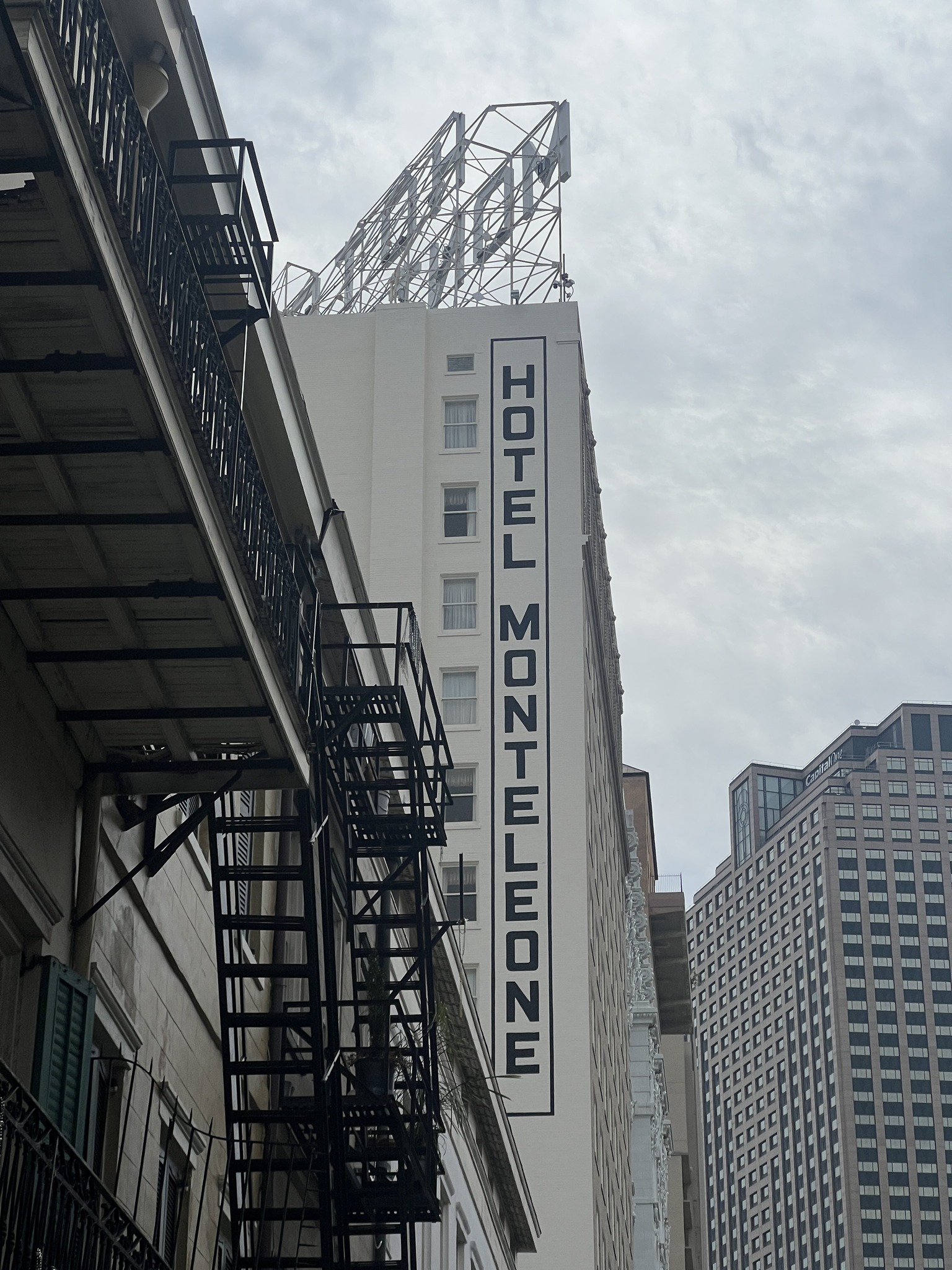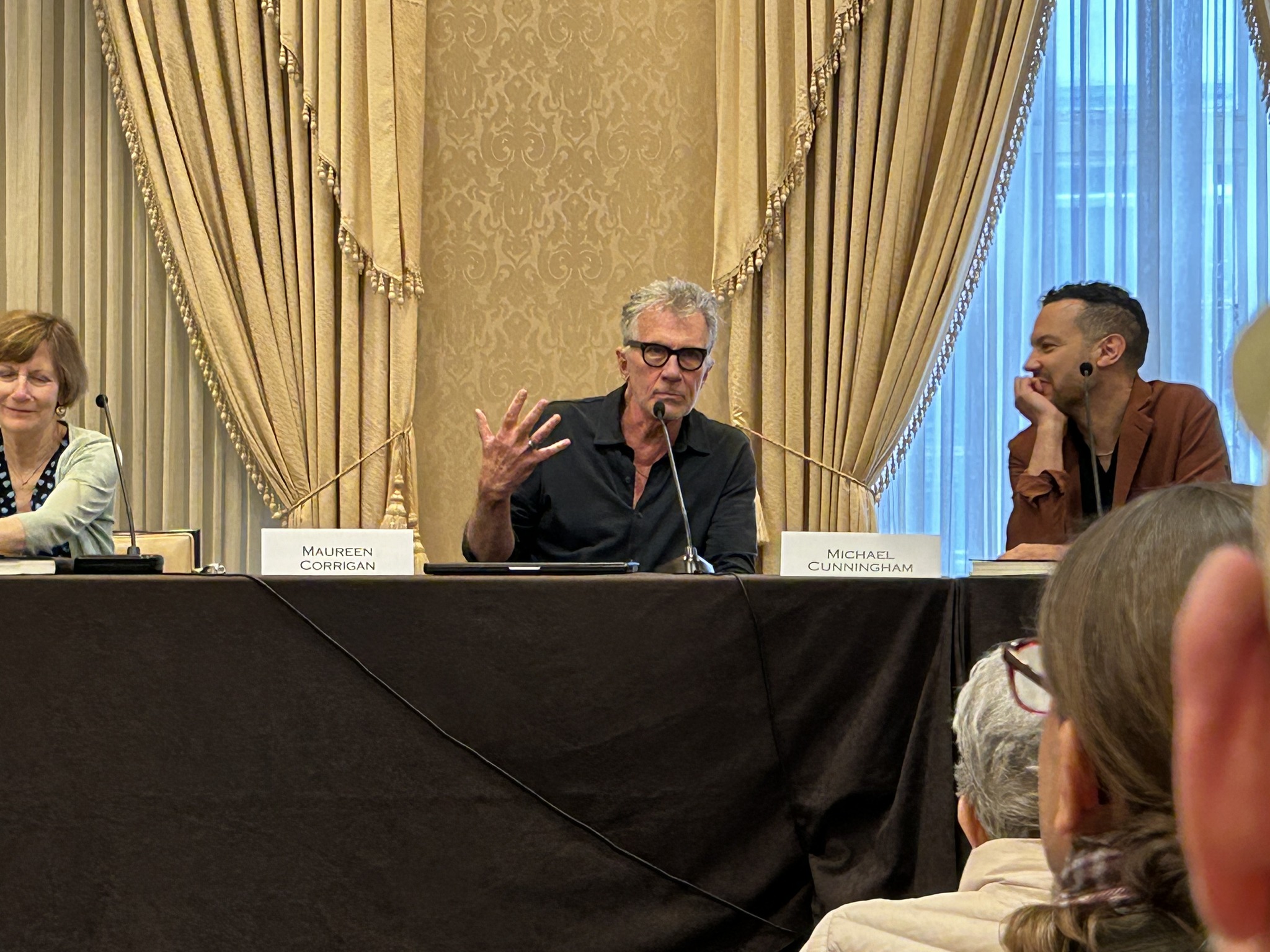After the long but great Friday, I slept very well in the Vrbo. So clean, with snacks, and a comfortable bed. Like I said, perfect.
There was a lot on today’s docket, but first was a Tennessee Williams walking tour of the French quarter. Whilst waiting for the tour guide to come collect us from the meeting spot, I met a very nice gentleman from Florida name Larry. We were having a very nice chat, and when I told him that I was the play competition winner, he got very excited. In fact he, insisted on getting a selfie with me. I have, suspicion, however, we less star struck and instead thought I was kinda cute. Shortly thereafter, we were met by the tour guide and headed out on our neighborhood journey. We visited several of the apartments Williams lived in, and learned the phrase “Shoebox Apartment.” This is not to suggest the apartment was small, although it certainly was–it referred to the fact that a tenant had to be prepared to shove all of their belongings into a shoebox and sneak out quickly. This was a necessity when the landlord would show up to collect past due rent. This is the sort of vagabond life Tennessee lived during his first time in New Orleans. One of the stories about one of these residences involved a jilted sailor out on the street shouting up to the playwright’s apartment: “Williams you bastard, you gave me crabs!”

I also learned about the Chinese and Italian histories in New Orleans–in fact, Stanley Kowalski was originally written to be Italian, but there were too many broadway plays running at that time featuring Italian villains, so Stanley was “WASPed” up. The tour guide also shared the fascinating factoid that the most common language spoken in New Orleans in the 1850s was German. As the tour guide put it, “Who do you think put sausage in all of our food?”
After the tour, I had three literary discussions I wanted to be sure to attend, the first of which was on Writing Southern Gothic in Modern New Orleans. I loved the discussion, and in particular loved learning about novelist Alex Jennings new work, “The Ballad of Perilous Graves.” In the novel, nine powerful songs have escaped from an important piano, imperiling the city of New Orleans. It falls to an 11 year old magician to find the songs and return them to the piano. Complicating the fact is the songs all think they’re people. It’s the kind of idea I wish I had thought up.
Following that I attended “History is My Muse: Finding Inspiration in the Past.” I was fascinated with several of the authors at this discussion, including Julia Mayle’s “Pelican Girls,” about poor women shipped from France to the Louisiana Territory to father to children of French colonists; Maurice Carlos Ruffin, who imagines his female ancestors were Union spies in “The American Daughters;” and perhaps most intriguing was Wendy Chin Tanner’s novel “King of the Armadillos,” which draws upon her father’s experience at the very last leprosarium in the United States, which just happened to be in Carville, Louisiana.
Next, I headed to a discussion between Maureen Corrigan and Colm Toibin. One of the great things about Colm is that he answers every question with a story. He discussed the intersection of history with his fiction, the challenges of admiring someone’s work whom you find personally repugnant, and his sequel to “Brooklyn.” (Fun fact about the film adaptation: it was the first time Saoirse Ronan played an Irish character). Even though Colm is a college professor, he doesn’t teach writing; he teaches literature, and finds that there is still joy in teaching difficult works like “Ulysses.” He find that each generation of young readers sees the book differently and develops insight he never considered, keeping the works fresh and exciting. I definitely want to study literature with Professor Toibin.

Now it was dinner time, which mean time to meet up with my friend Kara Krantz. I hadn’t seen Kara in ten years, shortly after meeting her for the very first time. She was directing one of the plays at my very first Play in a Day Festival, and since then, we’ve only been connected by social media. This would be the first time we’d have an actual conversation since the second Obama administration. Not to worry: Kara was great to talk to, and I enjoyed her company very much. We had a lovely dinner and it was great to reconnect. Kara would also attend the play reading on Sunday.
But there were to more places to be before my return to the Vrbo. I headed to a local theatre called The Twilight Room to see a one man show, entitled “Tennessee Rising: The Dawn of Tennessee Williams.” Actor Jacob Storms performed as the great playwright, chronicling his “Shoebox” period right through to his Broadway debut. Storms was phenomenal, and once the play ended in 1946, I really wanted it to continue. The play was followed by a talk back, wherein Storms discussed his acting and writing process, and how director Alan Cumming helped him refine the narrative.

And finally, I headed over to The Temple, the former home of Alistair Crowley, now owned by actor John Cameron Mitchell to see a performance of “Nightingale.” Performed by actor-musician Vinsantos, “Nightingale” was a powerful blend of monologue and music, inspired by Vinsantos’ own life and a minor character from one of Williams’ plays. Aside from being a strong actor, Vinsantos is an excellent pianist–like, Rick Wakeman good. After the show, Mitchell came out to do a talk back about the show, which Vinsantos clarified was still in the workshop stages. Mitchell was lovely, and very patient with me when I ran into him in the hallway and gushed, “You were so good in ‘Sandman!” (in my defense–he was). He also congratulated me on my playwriting award.
After the fullest of full days, I rideshared my way back to the Vrbo, and drifted off to sleep, knowing that an even bigger day awaited on Sunday.
March Madness
To be clear, this is not a post about college basketball. This is a post about the joyful stress that was my March 2024.
As the month began, I already knew it would be a busy month. March 2nd was the first day of rehearsals for my play “Invincible Summer,” and we would be rehearsing each Saturday until the performance in May. Being a full time teacher, and living over two hours from Darlene, it was clear that managing time this month would be a challenge. But it was in service to the first production of my play, which, after several near misses, was finally going to make it on stage.
March is also one of two months of the year where the “Playwright’s Binge” is observed–September being the other month. If you are not familiar with the Binge, the playwrights who participate agree to submit a play or query or another piece of writing to a contest, festival, theatre or publication. By the end of the month, they should have sent out 31 submissions. While that could be time consuming, sending out one thing a day is very manageable, even if you work full time. So, that was the plan–a daily submission, rehearsals every Saturday, and Darlene and I would do the best we could to see each other. It will be hard, but it will be fine.
Besides, it’s not like several other things are going to happen this month, is it?
The first thing that occurred was the news that my play “Save the Man” was accepted by the Depot for New Play Readings for their 24-25 season. That was exciting, but not really time consuming. Worth celebrating, but hardly a disruption.
The next thing was that actor Rich Henkels and I finalized our plan to do a Zoom table read for my screenplay, “Leviathan.” We met at the Off Page Film Festival in November, and decided that we would do the reading, with Rich’s acting group (Actors Think Tank) comprising the cast. After several months of back and forth emails, we settled on Tuesday, April 16 to do the reading. I put together a list of roles for the cast, and recruited the amazing Shonita Joshi to read stage directions. It was a bit of extra work as expected, but very manageable, totally exciting and worth it. So far, so good.
And then the calendar turned to March 12.
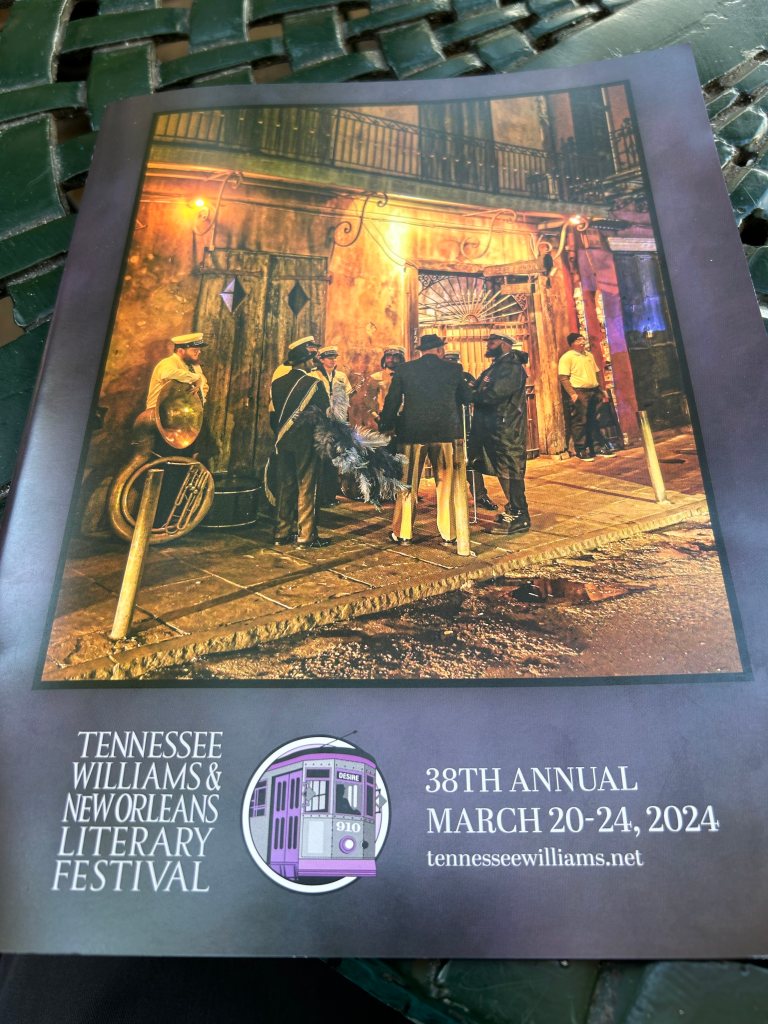
I had received an email in late February from the Tennessee Williams New Orleans Literary Festival informing me that I was a finalist in the One Act Play Competition, and that winners would be announced soon. That was a great honor, and I was pleased, but being a finalist wasn’t enough a motive for me to attend the festival–it was March 20-24. Besides, by the time we got to March 12, I knew that I had not won–after all, if I had, they certainly would have told me by now.
Then the email arrived: “You won!” Mind you, my excitement was tempered a bit by the message, given that it was addressed “Dear David.” I quick inquiry, and an apologetic note for the mistake, with confirmation I, Kevin, was indeed the winner. I would receive a cash prize, a pass to the entire festival, and a staged reading of my play. There was no real option now–I had to be there.
A hastily arranged Vrbo was secured, a reasonably priced flight was found (although it did not depart nor return to Boston at a reasonable time) and airport parking was arranged. I was in business, and ready to spend four days in New Orleans. On top of everything else.
So, yes, things got crazy. And my experience at the festival will be chronicled starting with the next post.
Off Page Film Festival
If you are a regular reader of this blog, you know that I love attending film festivals–particularly if a script I have written has placed me in one. I’ve been to some large festivals–Austin , Cinequest in San Jose (currently hopeful for a return trip in March) and some small ones (VisionFest in Tribeca, Mystic Film Festival in Connecticut). But I have never been to one as new as Off Page in Philadelphia. I attended the second annual festival in November, because my screenplay, “Leviathan”, was selected as a finalist. So, I hopped on Amtrak, checked into what is likely Philadelphia’s cheapest hotel, and made my way to the Venice Island Performing Arts Center.

Being small and new, the festival only lasted a day. But the nice things about smaller festivals is that it is easier to take in more (if not all) of the program and much easier to make connections and enjoy conversation with other creative types and film lovers. Although this wasn’t always the case, I have become the type of person who is comfortable starting conversations with strangers in these types of venues. Some of my favorite people on earth I have befriended at film festivals. Indeed, one of the primary organizers of Off Page, Brigette ReDavid, I met in Austin four years ago.
The program at Off Page was primarily shorts and trailers. And like most film festivals, the shorts were a mixed bag of quality, but there were some definite stand outs. “Astronaut” and “Tiger Hunt” (both directed by Brian McCole), “Millie’s Care Free Day,” directed by Michael Licisyn, a TV pilot called “Bad Atmosphere” directed by Mason Sperling and one of the best short films I have ever seen, “Self Tape” directed by Christopher Newhard. And even though my script did not win the award, it was overall a terrific day.
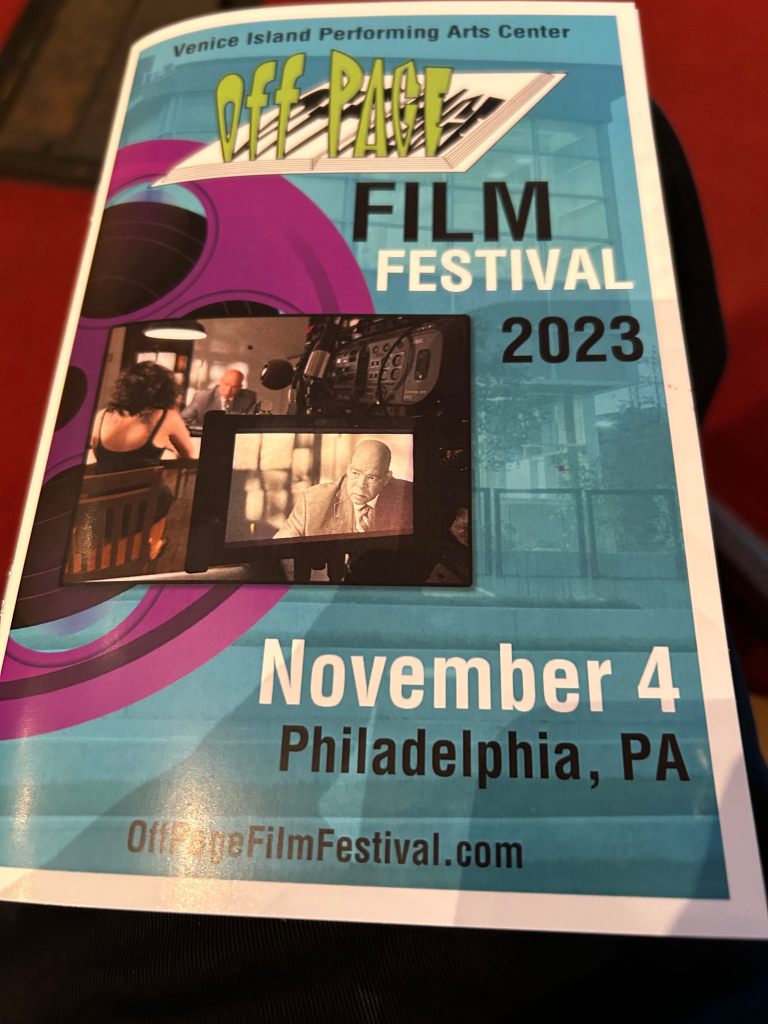
After the awards ceremony, we all retired to the nearby Manayunk Brewery for the after party. I got to chat with Brigette, whom I had not seen in person since Austin; I met Michael Licisyn, and talked with him enough to learn that he is the official videographer for the Philadelphia Phillies; I chose not to disclose to him that I am a San Diego Padres fan, because I had no desire to revisit the 2022 Major League Baseball playoffs (good for the Phillies, bad for the Padres). Aside from being a very astute filmmaker, Michael is witty and intelligent, and a great person to have a conversation with. I met writer David Laserson, who had the distinction of beating me in the feature screenplay category; we recently reconnected on LinkedIn and agreed to share our work. I also met Mason Sperling, and learned that “Bad Atmosphere” was completely improvised, and the NASA training facility set used in the show was constructed in his garage. I also got to meet Christopher Newhard, who I ended up engaged in a compelling conversation, wherein I learned about his life as a filmmaker, a rock musician, and a husband. He explained how “Self Tape” was in many ways a love letter to his wife (the ludicrously talented Robbie Jean, who stars in the film) after bearing witness to her struggles as a working actor. I also met the distinguished and highly skilled Rich Henkels, who appeared in several of the films at the festival (clearly a popular acting choice amongst Philly filmmakers). I learned Rich works with an acting troupe, and he offered to have his actors do a Zoom table read of “Leviathan.” I accepted his offer with gratitude and great enthusiasm. Hopefully, that will happen over the next few weeks.
Small it may be, but it is clear the Off Page film festival attracts very talented artists, some of whom I am very pleased to call my friends and acquaintances. I am optimistic about the festival’s future, and I look forward to returning.
An Act of Love
Like most humans, my life has been filled with ups and downs, ebbs and flows. I haven’t had too many of what I would describe as truly awful or terrible days. December 2, 2023, though, would turn out to be one of the worst.
It was on that day that my wife Darlene and I had to make the excruciating but necessary decision to euthanize Lollie, our English Shepherd.
To be fair, Lollie was an old dog. She was just a few months from her fifteenth birthday, and feeding her twice a day had become a project, given all of the medications and supplements that had to be added to her food. Mostly, they had to do with brain health, arthritis pain, urinary tract infections, incontinence and the like. We had nearly lost Lollie to pneumonia a year earlier–a battle she had won against the disease despite a nine day stay in the hospital.

So we knew the time was coming. And it is easy to allow ourselves to be fooled, because the truth is, that’s what we want. She has a good day, and we think the medication is working, and even though we know the day is coming, we think at least it won’t be soon. The fact is, Lollie was having a really good day–until she wasn’t.
A Friday night trip to the emergency vet indicated what we didn’t want to hear was likely at hand. A failed hail mary treatment, followed by a sleepless night from all three of us, left really only one decision left to be made in the morning. The fact is, Lollie couldn’t walk without losing her balance, she needed to be carried in and outside the house to do her business, and perhaps worst of all, she was frightened and anxious, unable to understand what was happening to her.
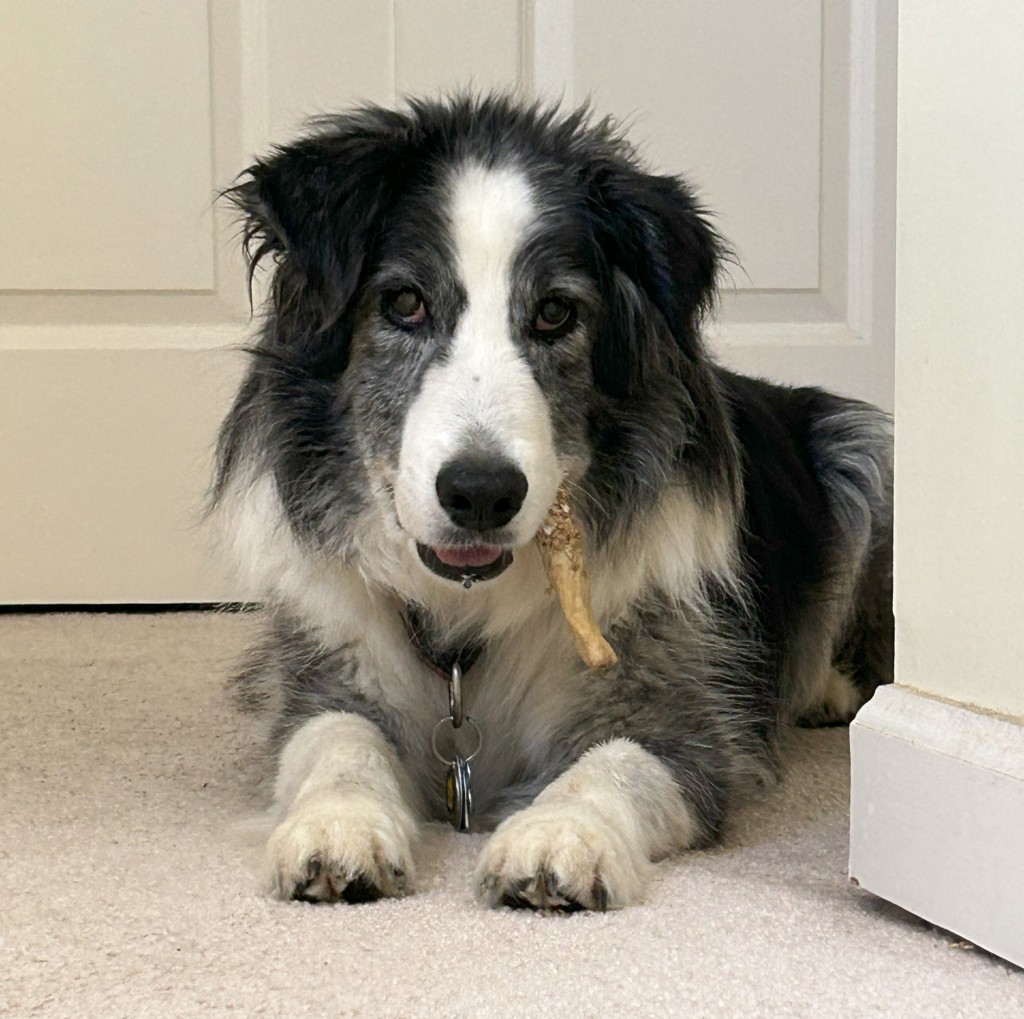
Even though I knew it was her time, I still didn’t want Lollie to go. And at the risk of anthropomorphizing, I don’t think she wanted to go. Much as she refused to give in to the pneumonia that tried to take her the year before, she continued to fight what was happening to her. In spite of her condition, she kept trying to follow us around, and do her job: making sure the herd (Darlene and I) was organized and safe.
John Katz describes in his excellent book “Going Home” how we have to act as advocates for our animals. This means when they are at the point when their quality of life is gone, we have the responsibility as pet owners–as those that love them the most–to decide that it is time for them to go. It’s a huge part of why animals trust us to feed, house and love them. They can’t communicate this to the veterinarians themselves–we have to do it for them. Ask any animal hospital employee and they all have stories of pet owners who kept their pets alive in misery far longer than they should have because they couldn’t bring themselves to say goodbye to their beloved dog or cat. As tempting as that is, we have to remember that our pets are trusting us to be their advocates. As Darlene told me, “This is the most selfless thing you will ever do.”

So we spent one last morning together. I fed Lollie two chicken breasts by hand, and then Darlene and I sat with her all morning, petting her, giving her chin and ear scritches, letting her know that despite how anxious she was, she wasn’t alone. When the time finally arrived, I carried her out to the car, and took the long, slow ride to the veterinarian. In one way, it was less than ideal, because the animal hospital may very well have been Lollie’s least favorite place in the world. But I am glad Darlene and I were with her, that we would be the last people she would see. If you are not familiar with the process, the vet gives two injections–the first is a sedative, which dispatches her to literal sleep, and then the second is an overdose of an anesthetic that sends her on her way.
I watched after the first injection, which sent her off to a much-needed peaceful sleep. I was happy her last memory wouldn’t be the pain and stress she had been feeling from her condition. I noticed her legs were pumping her through one final dream. I’ll never really know what that last dream, those last thoughts, that last memory was, but I hope it was of us hiking together, or one our evening walks, or her running up and down the stairs with her beloved busy bone, or playing in the yard with her favorite rope toy.
Actually, I have decided: it was all of the above.
.
…And We’re Back!
It appears that my play, “Invincible Summer” will have it’s staged production after all.
To recap, “Invincible Summer” has had, to significantly understate the matter, an interesting history. After my very first staged reading, the play helped get me my very own theatrical agent (Earl Graham). In, 2019, the play was accepted for a theatre festival in Brooklyn, New York–but then Covid happened, and the festival never returned.
That was not the worst of it. Earl (and his husband, a short time later) both died of Covid, putting the agency and my status as a client in something of a limbo. Not only was that around the same time my mother passed away, the entire world was in the process of turning upside down. I was heartbroken at Earl’s loss, but we were surrounded by heartache and all of us were, frankly, in something of a limbo.
As things began to open up in 2021, I received a phone call from theatre director Dana Sachs. Dana had read my play, and wanted to stage it as a Zoom reading. I agreed, and Dana went to work casting, rehearsing, and then performing the play on Zoom. Another Zoom reading, with a different director and cast, was done later that summer by the Depot for New Play Readings. I was very happy with both readings, and took steps to improve the play.
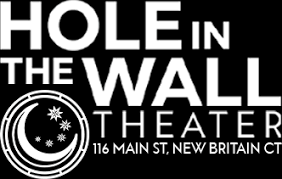
In 2022, Dana called to tell me he has arranged to stage the play in a theatre is Cheshire, Connecticut. We had signed a contract, begun rehearsals, when the theatre changed their minds and cancelled the play. We tried again at another community theatre who wanted us to do the play with them. It looked like it was going to happen, but then the director of the organization was stricken with cancer, and no one else in the organization was willing to step forward and share some of her burden. As a result, that show never materialized.
In 2023, things began to look up: I discovered that the new agency that was reorganized following Earl’s death would retain me as a client. Then, another phone call from Dana–the Hole in the Wall Theatre in New Britain, Connecticut would stage “Invincible Summer” in May 2024.
Remarkably, most of the cast from that first Zoom reading–Mark Gilchrist, Christie Maturo, Allan Church, Frank Dicaro and Jack Levine are in the cast for the production. They have been augmented by Lois Church, Jerry Rankin, and Val Solli. Dana is directing, and his wife Cynthia Parisi will be our stage manager.
I don’t really have the words to describe how amazed I am that this group of individuals have stuck with this production through all of its ups and downs over the last three years. I wouldn’t have blamed any of them from walking away (and certainly didn’t for the few that did so). This company, though, has paid me and my work a tremendous honor, and I am grateful for every single one of them. I can’t wait to see them all on stage…finally.
See you in New Britain in May.
Geographic Drama
Back in 2017, my play “Archetypes in Rehab,’ made its debut at the Playhouse on Park theatre in West Hartford, Connecticut. I wrote it for the theatre’s “Play in a Day Festival” which means I wrote it overnight in the theatre on Friday and it was performed in front of an audience on Saturday night. Luckily, I was blessed with a remarkable cast: Moira O’Sullivan and Sarah Vasconcelos (nee Kozlowski). I also had a terrific director named Erik Bloomquist. They worked hard all day long and did an amazing job performing the play. The audience loved it.

I felt even though I had written it in one evening, that with some tweaking the play had a chance to be more than a one night stand. So I did a revision, and then posted it on New Play Exchange (NPX). In 2021, I received an email from, of all the places, the United States Army entertainment division. They had located the play on NPX, and informed me they would like to do four performances on an army base in Germany. And they would pay me royalties. It appears my instincts were correct.
But that’s not all.
Last month (coincidentally, during a staged reading of another play) I received an email from a theatre student in Washington state named Madison Moore. Madison also found my play on NPX, and asked permission to stage the play as her senior project at Central Washington State University. I was happy to agree, especially since Madison informed me that it would not be performed in a theater–she would instead find a “pop-up” location out in the town of Ellensburg. It all sounded great to me. Madison also very politely requested the elimination of one line. I agreed to that as well, and it made me rethink just how necessary the line is in the play. Madison will be directing the play this summer.
Thus, “Archetypes in Rehab” is easily my most produced play, but also my only one to be performed on two coasts and two continents. I cannot wait to find who else finds it on NPX–my money is on a Kabuki adaptation in Omiya, Japan.
Please put your own guesses in the comment section below.
Staging a Reading for “Save the Man”
If you are familiar with my blog or my work, you might know that my very first play reading was “Invincible Summer” back in 2016. “Summer” had two subsequent Zoom readings, and has come very close to production on three separate occasions. I’ve also had productions of one act plays, but it wasn’t until now that another full length play felt it was ready for a staged reading.
Set In 1950, “Save the Man” is a Western Shoshone teenager fleeing his boarding school hides in a barn owned by a family of Sikh immigrants, who each must risk their safety to trust the other. The play is based in part on the experiences of my grandfather, who was forced to attend an American Indian boarding school when he was a child.
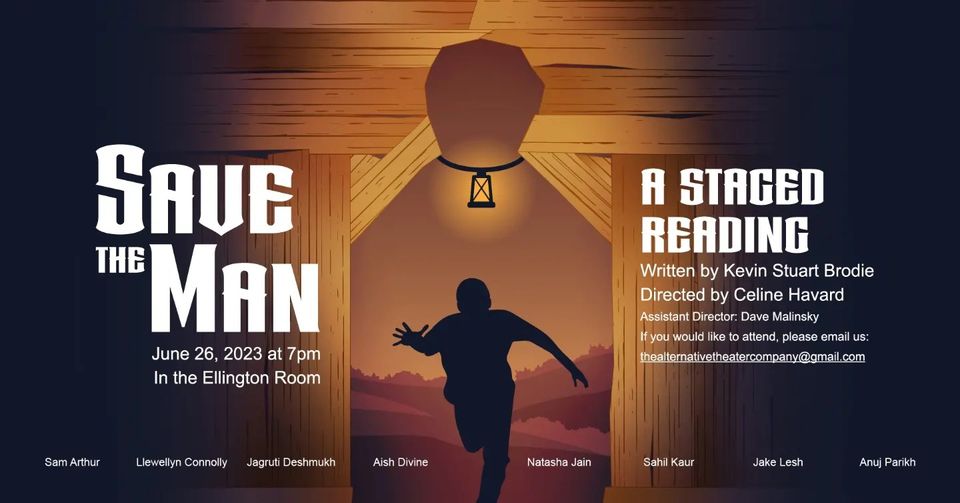
The decision to stage the reading raised the questions of: where should we do it and with whom? Over the winter, I spoke with my friend Larry Leinoff, a terrific playwright who helped my stage the “Summer” reading seven years ago. When we were brainstorming a director who would be a good fit for the play, we both had the same name in mind: Celine Havard.
Celine is a director, actor, producer, and runs her own theatre company: the Alternative Theatre Company. While I didn’t know Celine well, she is a part of the network of theatrical professionals I have connected with over the last few years–indeed, Celine is the daughter of playwright Lezley Steele, who is the best writing teacher I have ever had. I was happy that Larry had confirmed my intuition, so all that remained was to approach Celine.
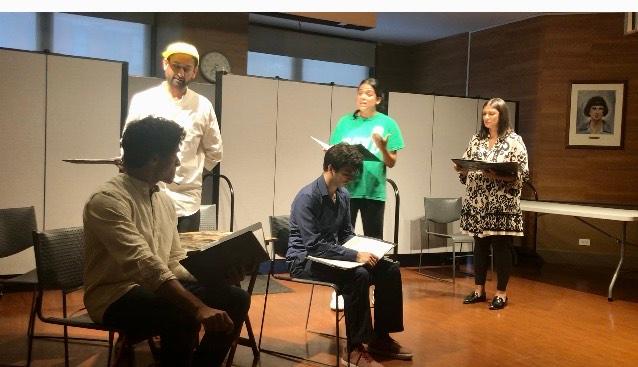
Happily, Celine was open to directing the reading, and most importantly, really liked the play. A relatively painless negotiation, some legal paperwork signed, and we were off and running. Celine recruited Dave Malinsky to be her assistant director and her son Lambert to be our stage manager. Celine also had access to a performance space–the Duke Ellington Room on Theatre Row in New York City. So, all we needed now was a cast.
Using Backstage.com, we posted notices and received many replies. Some turned in audition tapes, sent resumes, and did Zoom auditions. In April, we reserved space in Ripley-Grier studios for our in person auditions. This was the first time I had to enjoy this experience–in previous readings and productions casts were usually selected by actors known to the directors. It was exciting to be in Ripley-Greer, in the heart of the theater district, in a building filled with auditions, rehearsals, and choreography. The creative energy was palpable. For the first time, I felt like a professional playwright.
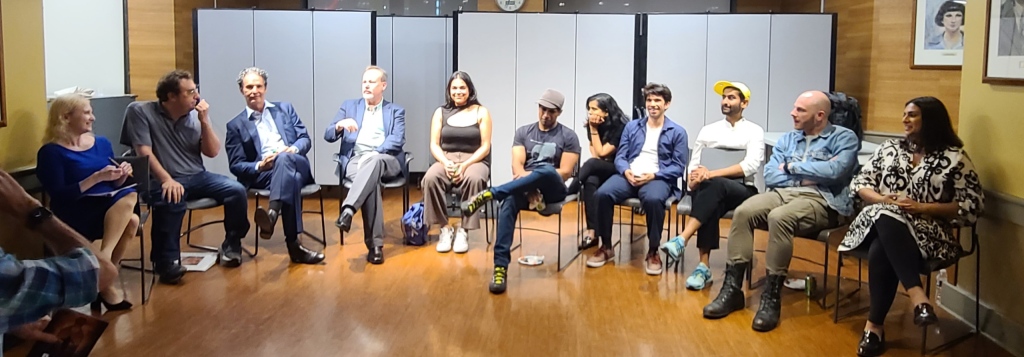
And after some bumps and scheduling difficulties, we had our cast: Sam Arthur, LLewellyn Connolly, Jagruti Deshmukh, Aish Divine, Natasha Jain, Sahil Kaur, Jake Lesh and Anuj Parikh. In the buildup to rehearsals, I worked with Celine and Dave to strengthen the script, and more ideas emerged from the rehearsal process. And then, on the evening of June 26, the staged reading.
I was incredibly impressed by the commitment of the cast, who put so much energy and passion into my work. They found aspects of the characters and the story I wasn’t even aware were present. Guided by Celine, they really made the story work on many levels, and the audience responded positively to the reading. It was also fascinating to hear from the audience what they thought worked and what they thought did not, and to hear from the actors how they approached the choices they made. I now have clear ideas on what I can do to improve the script, and prepare it for a possible future production. Hopefully, when I mention “Save the Man” again, that is what I will have to report.
The Prison of Belief
I have to admit, I have stolen this title from Lawrence Wright’s superb book about Scientology, “Going Clear.” Part of the reason this is on my mind is due to the fact that over the past few weeks I have been watching Leah Remini’s show on the Aftermath of Scientology, which she co-hosts with fellow former scientologist Mike Rinder. Mr. Rinder also frequently invokes that phrase since it patently describes what life is like as a scientologist.
If you aren’t familiar with Mike Rinder, he was a scientologist for 46 years–and was an important, high ranking member of the church until his departure in 2007. He was raised in Scientology as a child, and knew nothing else–his entire family were members. And when he left the church, his family (as is common practice) refused to have any contact with him and dismissed him as “evil” in media reports. In spite of this, Mr. Rinder has made a good life for himself, remarrying and having children, and devoting his life to educating the public about Scientology and assisting other members of the church who have departed and also been disowned by their families. Mr. Rinder is honest about the awful things he did in Scientology, and has worked hard to make amends with those he harmed. What I have learned about Scientology from Ms. Remini and Mr. Rinder reminds me of a quote from physicist Steven Weinberg: “With or without religion, good people can behave well and bad people can do evil; but for good people to do evil – that takes religion.”
I bring all of this up because I think it provides insight into our current politics. The “Prison of Belief” is not confined simply to cultish institutions like Scientology, Jehovah’s Witnesses, and the Unification Church (known as the Moonies). I think this prison can manifest itself today with the likes of QAnon, Proud Boys, and even benign sounding organizations like Moms for Liberty.

Many such conspiratorial organizations are not simply expressing a view or a vision of what society should look like that might be different from mine, or yours, and any number of people. Indeed, factions with differing visions of what the country or civilization should look like go back to the founding of the nation. Of course, there have always been extreme factions uninterested in compromise or having their thoughts enter the “marketplace of ideas” as Justice William O. Douglas would later put it. Such compromise was not possible because those who differed with the views of extremists were considered “enemies” “traitors” and, of course, “evil.” Historically, this was not always a cause for alarm, because such groups were fringe religious cults or hate groups largely confined to the margins (the Ku Klux Klan’s early 20th century resurgence being something of an exception).
Today, the margins have moved to the center of the page. QAnon has elected its adherents to Congress. The President of the United States implores the Proud Boys to “stand back and stand by.” Moms for Liberty candidates win school board races, and in one case in Georgia, fire a superintendent without cause. These groups bear a remarkable resemblance to Scientology and other cults–those that oppose them are satanists, a cabal of child traffickers, school officials “grooming” straight kids to become gay or trans. It is tempting to simply laugh them off, but they too are imprisoned by their beliefs. It is difficult–if not impossible–to have any sort of dialogue with individuals from these and like-minded organizations. Every counterexample is either a lie or more evidence of the conspiracy.

Of course, members of QAnon or Moms for Liberty don’t suffer the same consequences for leaving as those of Scientology. They are not necessarily cut off from all of their friends and family whilst trying to navigate through the world without an education or much in the way of life skills. Those who are contemplating a departure from Scientology know what the cost is, and that awareness often keeps them tethered. Whereas someone mired in QAnon is staying not because they fear the consequences of leaving, but because they believe they are correct. This, I think, is far worse.
Being a professional educator, I know that I am among those who are viewed as wicked, traitorous or abusive. The facts do not matter, and it is difficult to protest otherwise; as attorney Marc Elias says “there is no middle ground between an arsonist and a firefighter.” I would love to be able to say that there is a solution to this problem, or simply dismiss it as a select few, and comfort myself with the fact that these views are not majority opinions. As scientologists are a small number, so too are the Proud Boys and the Moms for Liberty.
But that’s the thing–there don’t have to be a lot. There just has to be enough.
The Big Tall Wish
We met at the trailhead of Mt. Willard in New Hampshire at 3:45 a.m. Myself, Darlene, Kelly the Justice of the Peace and Shado and Isabelle, the photographers. And it wasn’t just that we were meeting to begin a hike–we were literally all meeting for the first time.
What was perhaps most remarkable about today is that we were here at all. Throughout much of my five plus year relationship with Darlene it was clear to both of us that we didn’t want to get married. Not only did it lack emotional appeal for us, it also seemed impractical. We lived in different states, and until we retired we’d never be able to cohabitate–and retirement was still several years away.

Leah, Darlene’s oldest granddaughter, viewed the matter very differently. She definitely wanted us both to be married, and would occasionally bring it up, usually in the form of a question: are you going to get married? Do you think you will get married? This was often followed by Leah’s suggestions on what our wedding should be like (the Avengers themed wedding seemed to have the most appeal. To Leah, at least.). Even though we didn’t really give Leah any reason to be encouraged we were headed that way, we sometimes found ourselves discussing it. Absolutely not. Well, there would be some financial benefits. But that’s not a reason to get married. No way. What, we’re going to be married and live in different states? That’s stupid. Well, if we ever decide to do it someday–at some distant point in the future–it will just be you and I on a mountaintop.
And then one day last spring, perhaps because we stopped analyzing it, we decided to do it. Just because. Just because it felt right. On a lovely March afternoon in Rhinebeck, New York, we walked into Bread Alone cafe hungry for lunch, and walked out engaged. But this was going to be our secret. We were eloping. And we weren’t going to tell anybody until after we came down off the mountain.
But which mountain? Some Google searching and we settled on Mt. Willard, near Bretton Woods in New Hampshire. It looked beautiful, the hike seemed reasonable, and Darlene was born in New Hampshire. A perfect fit. What we needed now was a photographer and a justice of the peace that were game for an early morning mountain hike in the darkness to do a wedding. I would like to tell you it was difficult, but it really wasn’t: Shado and Isabelle are young, energetic, and outdoorsy, so they loved the idea. Kelly was an experienced hiker who lived twenty minutes away from Mt. Willard. We found them all on the internet–it was shockingly easy.

So there we all were, a bit awkward at first, hiking a mile and half up the mountain in the darkness. I had found a garment bag that folded up into a backpack, so my blazer and all of our other supplies fit perfectly in it. We hooked Darlene’s dress onto the backpack, then sherpa’d our way up Mt. Willard.
We changed into our marriage ware, and took a look at the mountaintop. It was perfect–the light, the clouds, the temperature–we could not have custom ordered a more ideal day. The beauty of the mountaintop immediately washed away any awkwardness between us all–it became instantly clear why we were doing this here. We all seemed overcome with joy, and all started to feel like friends.
Of course, no one was more joyous than Darlene and I. As you can see, we had wonderful photos, and Kelly did a terrific job with the ceremony. I have never been as deliriously happy as I was the day Darlene and I became husband and wife on that New Hampshire mountaintop.

Darlene and I have a tradition wherein on New Year’s Eve we light wish paper and watch it float up to the heavens as we silently make a wish. We discovered during this recent New Year’s ceremony that we both had the same wish a year ago.
And it did indeed come true.
